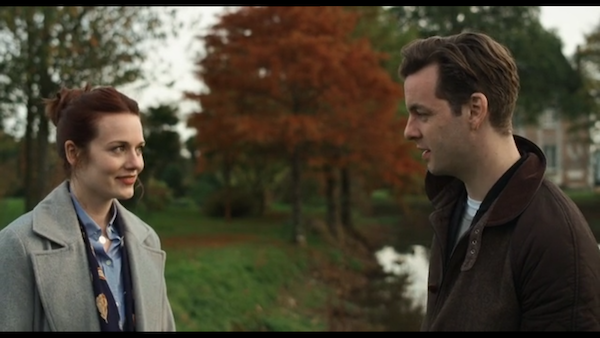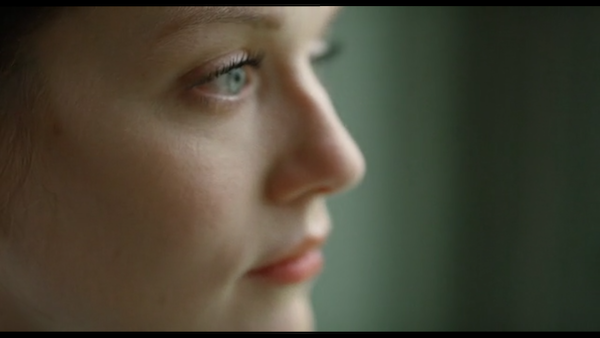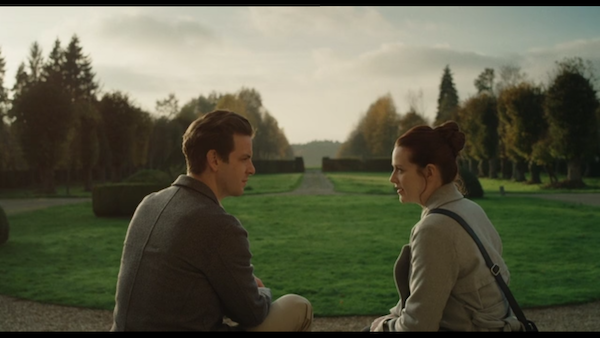Two people who meet outside a Normandy chateau play out several versions of their encounter in this accomplished, involving miniature.

Around the Sun unfolds like the answer to an exam question: Make a viable drama with a microbudget, one location and two cast members. Director and producer Oliver Krimpas and screenwriter Jonathan Kiefer turned to a seventeenth-century text for inspiration, adapting Conversations on the Plurality of Worlds into a romance that splinters into parallel narratives.
Broken into five chapters (with a few footnotes), the story proceeds in fits and starts, repeating dialogue and scenes from different angles, adding and subtracting background details, slipping forward and backward in time. Two characters appear in all the plot lines. Maggie (Cara Theobold), possibly a realtor or location scout or stalker, is showing a Normandy estate to Bernard (Gethin Anthony), a director of special projects or playboy or wounded moralist determined to restore his father’s name.
Bernard might want a film location, or buy a real estate he can turn into the satellite campus of a tech start-up. Maggie might want to rent or sell or buy the estate. In separate scenes she reveals background about who lived in the chateau and what took place there—details that form the core of the film’s plot.
In 1686 the philosopher and scientist Bernard le Bovier de Fontenelle published Conversations on the Plurality of Worlds, an account of the time he spent at the chateau with his hostess, a widowed aristocrat. Their discussions explored possibilities opened by Copernicus, whose model of the universe upended the accepted standard established by Ptolemy. No longer was earth the center of the universe.

Maggie believes the Copernican model can explain how relationships work, leading to debates that are spirited, intricate, hostile, flirty. The plurality of worlds they experience means that Bernard can be married, divorced, single, even a father. Maggie is alternately cruel, seductive, curious, cynical. There are some constants in the film: the cars they arrive in, their walks through fields and forests, a well-appointed library, a smaller chateau falling into ruin.
What will happen to Maggie and Bernard is the core question in Around the Sun, one that ultimately matters only if the performers can hold viewers’ attention. As Maggie, Cara Theobold is riveting, her open face revealing emotions her character is unable to hide even as she dances out of Bernard’s grasp. Gethin Anthony has more trouble winning sympathy, perhaps because he seems to hold back his feelings. There’s a distance between the two performers that may or may not be what the filmmakers intended, a reserved tone that wants viewers to make an intellectual commitment to what they’re watching.

The film’s repetitions and reworkings are mostly fun, only occasionally too obscure or precious. Cinematographer Michael Edo Keane use slightly different setups and camera moves to introduce the chapters, while capturing exquisite glimpses of the chateau. The blocking and editing are perfunctory, again perhaps due to finances. Some scenes fall inert as a result.
Make no mistake: this is a bare-bones film whose tiny budget is always apparent. With its prolonged conversations and condensed time span, the story may remind viewers of Richard Linklater’s Before Midnight trilogy. Back in 1981, Francis Ford Coppola’s struggles to write a movie version Goethe’s Elective Affinities led to his big-budget romance (and box-office failure) One From the Heart. For all its limitations, this is a far more interesting adaptation.
Around the Sun played at several festivals in 2019 and had additional screenings scheduled for 2020, as well as a potential February digital release. Like almost everything today, those plans are in abeyance. Maybe better news awaits in a parallel story line.


